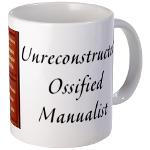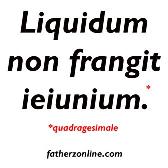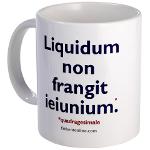 Tomorrow is Good Friday. Let’s review our obligations before the day arrives so that we aren’t taken by surprise.
Tomorrow is Good Friday. Let’s review our obligations before the day arrives so that we aren’t taken by surprise.
Two days of the year we modern Latin Church Catholics are asked both to fast and to abstain from meat.
According to the 1983 Code of Canon Law for the Latin Church, Latin Church Catholics are bound to observe fasting and abstinence on Ash Wednesday and Good Friday.
Here are some details. I have posted them before, and I am sure you know them already, but they are good to review.
FASTING: Catholics who are 18 year old and up, until their 59th birthday (when you begin your 60th year), are bound to fast (1 full meal and perhaps some food at a couple points during the day, call it 2 “snacks”, according to local custom or law – two snacks that don’t add up to a full meal) on Ash Wednesday and Good Friday.
Since we are Unreconstructed Ossifed Manualists, we pay attention to old manuals. Prümmer suggests that for the morning snack a piece of bread and 2 ounces of nourishing food is sufficient, and that for the afternoon or evening snack, 8 ounces of nourishing food is permitted to all. “Sufficient” for what is not entirely clear. There is a difference between working construction and working at a computer. This is greatly simplified by taking Good Friday off… if possible.
There is no scientific formula for this. Figure it out.
ABSTINENCE: Catholics who are 14 years old and older are abound to abstain from meat on Ash Wednesday and on all Fridays of Lent… and Good Friday in the Triduum.
In general, when you have a medical condition of some kind, or you are pregnant, etc., these requirements can be relaxed.
For Eastern Catholics there are differences concerning dates and practices. Our Eastern friends can fill us Latins in. As I understand, the Byzantine (Ruthenian) Catholic Church in these USA has followed the Latin rite to a certain extent. Abstinence from meat is required on all Wednesdays and Fridays of Great Lent, with the the strict fast (abstinence from meat and dairy) on Clean Monday and Good Friday.
You would do well to include works of mercy, both spiritual and corporal.
I also recommend making a good confession. Let me put that another way:
GO TO CONFESSION!
“But Father! But Father!”, some of you are saying anxiously, “What about my Mystic Monk Coffee? I can drink my Mystic Monk Coffee, can’t I? Can’t I?”
You can, of course, with and as part of your full meal and two “snacks”(portions that wouldn’t make a full meal) . No question there.
 How about in between?
How about in between?
The old axiom, for the Lenten fast, is “Liquidum non frangit ieiunium … liquid does not break the fast”, provided you are drinking for the sake of thirst, rather than for eating. Common sense suggests that chocolate banana shakes or “smoothies”, etc., are not permissible, even though they are pretty much liquid in form. They are not what you would drink because you are thirsty, as you might more commonly do with water, coffee, tea, wine in some cases, lemonade, even some of these sports drinks such as “Gatorade”, etc.
Again, common sense applies, so figure it out.
Drinks such as coffee and tea do not break the Lenten fast even if they have a little milk added, or a bit of sugar, or fruit juice, which in the case of tea might be lemon.
Coffee would break the Eucharistic fast (one hour before Communion), since – pace fallentes – coffee is no longer water, but it does not break the Lenten fast on Ash Wednesday or Good Friday.
You will be happy to know that chewing tobacco does not break the fast (unless you eat the quid, I guess), nor does using mouthwash (gargarisatio in one manual I checked) or brushing your teeth (pulverisatio – because tooth powder was in use back in the day).
If you want to drink your coffee and tea with true merit I suggest drinking it from one of my coffee mugs. I’d like to offer an indulgence for doing so, but that’s above my pay grade.
There’s always the Liquidum non frangit ieiunium mug.



































Just a little something to add: it is not known by many is that Holy Saturday – up until the time of the Easter Vigil – is also a day of fast in the Latin Church – though not an obligatory one. In the “Universal Norms for the Liturgical Year” which you will find printed in the front of the altar Missal, you will find (n. 20) “On Friday of the Passion of the Lord (Good Friday) and, if appropriate, also on Holy Saturday until the Easter Vigil, the sacred Paschal Fast is everywhere observed.”
It’s good to remind ourselves to go beyond the strictly obligatory sometimes – taking into account, of course, an individual’s particular circumstances.
In Japan, fast/ab is very easy. Portions of food are tiny to begin with. Friday fast/ab: miso soup for breakfast, very small rice ball (onigiri) for lunch and dinner is sushi/sashimi.
Okay, coffee with a small amount of milk is okay, got it. What about cappuccinos? i.e. 1.5 ounces of espresso with 3 ounces of milk? And three of them?
To be completely honest, my idea of a “fast” includes three of the above-described cappuccinos, up to 10 sticks of chewing gum (not swallowed, obviously) and a few 8oz cups of milk in the evening.
How does that sound?
Well, what about the cappuccino?
It looks to me like a quite good example of a morning allowance. One. With nothing else. Okay, maybe one abbraccio or pan di stelle or the like. Just one.
(The question of drinking it as part of the evening or, in case of a switch, midday collation is moot; one does not drink cappuccino but in the morning – or maybe, after Holy Mass, the early midday, but there is no Mass on Good Friday.)
As an in-between: no. It is not the idea of a cappuccino to be drunk for thirst – at least not to the Italians.
– Beer is nourishing too, but the idea of beer is that it is drunk for thirst, and that is the important thing. Which is why I’d be hesitant about apple juice, but quite certain that apple soda (or, a fortiori, rhubarb soda) is okay for an in-between: because the idea of apple soda (this might be a peculiarly German thing: a mixture of a apple juice and a sparkling water, in a 1:1 ratio or with slightly more juice) is indeed that it is drunk against thirst.
Chewing gum? One after each meal and collation seems okay. After all, they are hardly nourishing.
The point is, they must in a sensible manner be part of the meal or the collation. Catholics may traditionally be somewhat soft on the amount of what constitutes a collation, but it does belong to the fast that nothing at all is eaten unless for the one meal and two collations.
(Which is, I guess, how the idea of “fasting means not eating sweets” ever came up: Sweets are usually eaten at the afternoon coffeetime. And while breakfast and even supper might possible be defended as collations and, by the less pious, extended to rather normal meal-size, the afternoon coffeetime is the meal that definitely does fall away.)
So, in what is I guess the intended sense, chewing gum is out.
@Imrahil, thanks!
I looked rather longingly on my husband’s apple juice today…
Should have read: my Lutheran husband’s apple juice.
Anyway, what about the apple (or for that matter orange) juice? Or the skim-milk of the Wisconsenians (what’s the word for them?)?
They might be borderline cases, especially with the apple (at least for a German, because for drink a German would put sparkling water into the juice), but they still are at any rate more the likeness of “genuine beverage” than in the likeness of “milk-style food”.
[The denizens of Wisconsin are often called “Cheeseheads”. Sometimes they are called “Sconnies”. But I am from Minnesota, and I shall not share what we call them.]
(Except, I guess, for the latter – which I intended to delete from the comment, but there goes.)
Please edify me on Holy Thursday&Good Friday. When I was young( pre-VII):
– there was not feet washing of anyone. Last night there was feet washing of laity, 12 individuals. One woman( not Catholic), 4 school age children, 7 men.
– only the priests received Communion in Good Friday when I was young
There is as Communion today.
It’s a NO church. Our Rockford, IL bishop won’t let diocesean priest say a TLM without his approval. I’ve asked the Vicar over our deanery and he says, “We aren’t allowed to say a TLM”. I asked if he would ask for us. He said it won’t get approved.
Chewing gum is mentioned by St. Alphonsus de Liguori, IIRC, in the form of pine tar, mastic, etc. And he said it was okay, but not to smack your lips and chew obviously, so as not to cause scandal. Basically it is a medicine or a neutral substance even if flavored; and if you are stupid or desperate enough to swallow it, it is stupid but no sin.
Can someone find the part in the law about how the two “snacks” cannot add up to one full meal?
It seems that we are making this overly complicated. “Liquids do not break the fast” is a very straightforward statement, and manualists such as Noldin list water, milk, coffee, tea, juice, beer, wine, and even hot chocolate as examples of permissible liquids. There is no limitation on the amount of liquid that can be drunk nor on the motivation for drinking it. Drinking liquids because one is “thirsty” is only one purpose, with others including preventing dehydration, providing nourishment, and altering mood.